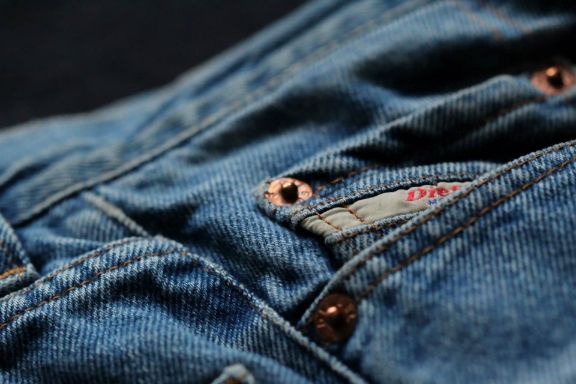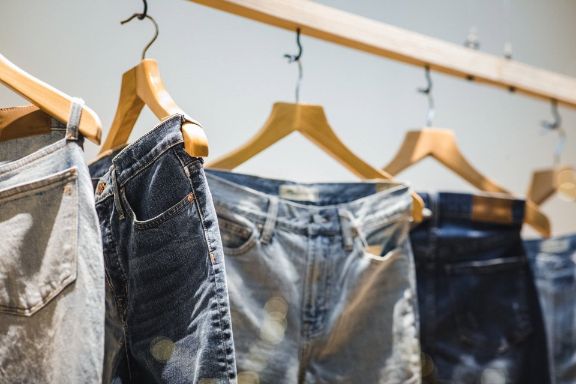How significant has denim been to the growth of global fashion industries? For starters, it produced over $120 billion in retail sales last year. To put that in perspective, the top three clothing brands in 2021, Nike, Louis Vitton, and Hermes, collectively earned $90 billion. Whether we’re talking about men’s jeans or women’s jeans, modern denim comes in a dazzling array of styles and cuts. It’s one of the most ubiquitous fashion textiles in history, but how did jeans become so widespread? Join us as we take a look at the context behind one of fashion’s most versatile garments.
Past to present
For whatever reason, the history of denim is an oft-overlooked subject. Despite its rather fascinating origin story, not many people know how it is, exactly, that denim became as popular as it is today. Our story begins all the way back in the 15th century when both Italy and France were experimenting with twill fabrics. On the Italian side, the city of Genoa created the first cotton-based jeans. These durable garments were made primarily for the working class.
In France, the city of Nîmes took note of what the Italians were up to and decided to create their own version of jeans. French jeans used a coarser, higher-quality fustian textile; this was the point when denim jeans were created. The word ‘denim’ is derived from “de Nîmes,” which is French for “from Nîmes.” Fast forward to the start of the 19th century. At this point, denim is a crucial textile for working-class clothing in Europe. However, we’re still missing a critical component of the denim jeans we all know and love – rivets. Enter Levi Strauss and Jacob Davis, two American entrepreneurs who added riveted stitching to jeans, making denim clothing a whole lot more durable. So durable, in fact, that jeans became the primary workwear for factory workers, miners, and farmers. Also read: Things You Should Know About Men’s Suspenders
20th century fashion
Jeans became fashionable during the 1950s and ‘60s, where they played a key role in US popular culture. Thanks to movies like 1955’s Rebel Without a Cause, teenagers instantly latched onto the idea of jeans being a symbol of rebellion against authority. In the 1970s, jeans were considered casual wear in the US. By the latter half of the 20th century, jeans as casual wear became a standard of international fashion. Soon enough, clothing boutiques and fashion houses began creating their own styles, distressing and washing the denim to create a diverse range of styles. From deliberate tearing to purposeful fades, this marks the point where denim truly became ubiquitous. If you think about it, the rapid proliferation of jeans is quite astonishing. It took almost two centuries to develop into a final product, yet it grew to worldwide recognition in less than 30 years.
According to multiple studies, denim jeans are now considered a preferred garment for 70-80% of all US citizens, irrespective of age or gender. The average American owns seven to eight pairs of jeans. They’re constantly seen in all forms of media, such as movies, television series, and reality shows. From both social and cultural perspectives, jeans are immensely prevalent in all aspects of modern society. By combining durability with such a plethora of styles and cuts, jeans can be used for almost any scenario you can imagine. The denim itself can be found in all types of clothing, from hats to shoes and everything in-between. Also read: Trending Jeans For Women
True versatility
The secret to the success of jeans lies in their durability. From sandblasting to chemical treatment, pre-shrinking to custom dyes, that durability has led to versatility beyond that of most other textiles. The only other material that comes close is leather, but even that doesn’t match up with denim, at least when it comes to jeans in particular. Whether it’s affordable everyday wear or exclusive designer labels, jeans come in all shapes and sizes. They can be loose or tight, plain or covered in jewels. They can be faded, blasted, printed, and shrunk. In terms of style and finish, there’s simply no other garment with as much diversity. Since they were designed primarily with functionality in mind, jeans provide a stable foundation for creativity. Like t-shirts, shoes, and jackets, they’re a category of clothing in their own right and can be used in almost every situation.
twitter facebook linkedin whatsapp
This subscription won’t wake you up in middle of the night, we are not your sweetheart! Register today for free and get notified on trending updates. I will never give away, trade or sell your email address. You can unsubscribe at any time.

